
Concept explainers
Draw structures corresponding to the following systematic names:
(a) (4E)-2, 4-Dimethyl-l, 4-hexadiene
(b) cis-3, 3-Dimethyl-4-propyl-l, 5-octadiene
(c) 4-Methyl-l, 2-pentadiene
(d) (3E, 5Z)-2, 6-Dimethyl-1, 3, 5, 7-octatetraene
(e) 3-Butyl-2-heptene
(f) trans-2, 2, 5, 5-Tetramethyl-3-hexene
a) (4E)-2, 4-Dimethyl-1, 4-hexadiene.
Interpretation:
The structure corresponding to the systematic name (4E)-2, 4-dimethyl-1, 4-hexadiene is to be drawn.
Concept introduction:
The longest carbon chain containing the double bond to be chosen. Based on the name of the parent compound–the alkene name ends with the suffix–alkene. The chain is to be numbered from the end that gives the lowest number to the carbon in double bond. Substituents are to be numbered according to their positions in the chain and listed alphabetically. The position of the double bond is indicated by giving the number of the first alkene carbon before the name of the parent name. If more than one double bond is present, their positions are indicated with the suffixes -diene, -triene and so on. The isomer that has the higher ranked groups on each carbon are on the same side of the double bond is said to have Z configuration. If the higher ranked groups are on opposite sides, the alkene is said to have E configuration.
To draw:
The structure corresponding to the systematic name (4E)-2, 4-dimethyl-1, 4-hexadiene.
Answer to Problem 38AP
The structure corresponding to the systematic name (4E)-2, 4-dimethyl-1, 4-hexadiene is
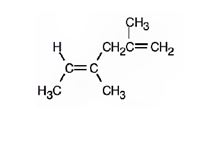
Explanation of Solution
The name shows that the longest carbon chain should contain six carbons with two double bonds between C2 & C3 and C4 & C5. There should be two methyl substituents one on C2 and other on C4. Further higher ranked groups on each carbon should be in the opposite sides of the double bonds.
The structure corresponding to the systematic name (4E)-2, 4-dimethyl-1, 4-hexadiene is

b) cis-3, 3-Dimethyl-4-isopropyl-1, 5-octadiene.
Interpretation:
The structure corresponding to the systematic name cis-3, 3-dimethyl-4-isopropyl-1, 5-octadiene is to be drawn.
Concept introduction:
The longest carbon chain containing the double bond to be chosen. Based on the name of the parent compound–the alkene name ends with the suffix–ene. The chain is to be numbered from the end that gives the lowest number to the carbon in double bond. Substituents are to be numbered according to their positions in the chain and listed alphabetically. The position of the double bond is indicated by giving the number of the first alkene carbon before the name of the parent name. If more than one double bond is present, their positions are indicated with the suffixes -diene, -triene and so on. The isomer that has similar groups on each carbon on the same side of the double bond is called as the cis isomer. The isomer that has similar groups on each carbon on the opposite side of the double bond is called as thetrans isomer.
To draw:
The structure corresponding to the systematic name cis-3, 3-dimethyl-4-isopropyl-1, 5-octadiene.
Answer to Problem 38AP
The structure corresponding to the systematic name cis-3, 3-dimethyl-4-isopropyl-1, 5-octadiene is
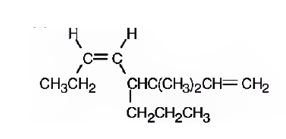
Explanation of Solution
The name shows that the longest carbon chain should contain eight carbons with two double bonds between C1 & C2 and C5 & C6. There should be two methyl substituents on C3 and an isopropyl group on C4. Further similar groups in each carbon should be on the same sides of the double bonds.
The structure corresponding to the systematic name cis-3, 3-dimethyl-4-isopropyl-1, 5-octadiene is

c) 4-Methyl-1, 2-pentadiene.
Interpretation:
The structure corresponding to the systematic name4-methyl-1, 2-pentadiene is to be drawn.
Concept introduction:
The longest carbon chain containing the double bond to be chosen. Based on the name of the parent compound–the alkene name ends with the suffix–ene. The chain is to be numbered from the end that gives the lowest number to the carbon in double bond. Substituents are to be numbered according to their positions in the chain and listed alphabetically. The position of the double bond is indicated by giving the number of the first alkene carbon before the name of the parent name. If more than one double bond is present, their positions are indicated with the suffixes -diene, -triene and so on.
To draw:
The structure corresponding to the systematic name 4-methyl-1, 2-pentadiene.
Answer to Problem 38AP
The structure corresponding to the systematic name 4-methyl-1, 2-pentadiene is

Explanation of Solution
The name shows that the longest carbon chain should contain five carbons with two double bonds between C1 & C2 and C2 & C3. There should be amethyl substituent on C4.
The structure corresponding to the systematic name 4-methyl-1, 2-pentadiene is

d) (3E, 5Z)-2, 6-Dimethyl-1, 3, 5, 7-octatetraene.
Interpretation:
The structure corresponding to the systematic name (3E, 5Z)-2, 6-dimethyl-1, 3, 5, 7-octatetraene is to be drawn.
Concept introduction:
The longest carbon chain containing the double bond to be chosen. Based on the name of the parent compound–the alkene name ends with the suffix–ene. The chain is to be numbered from the end that gives the lowest number to the carbon in double bond. Substituents are to be numbered according to their positions in the chain and listed alphabetically. The position of the double bond is indicated by giving the number of the first alkene carbon before the name of the parent name. If more than one double bond is present, their positions are indicated with the suffixes -diene, -triene and so on. The isomer that has the higher ranked groups on each carbon are on the same side of the double bond is said to have Z configuration. If the higher ranked groups are on opposite sides, the alkene is said to have E configuration.
To draw:
The structure corresponding to the systematic name (3E, 5Z)-2, 6-dimethyl-1, 3, 5, 7-octatetraene.
Answer to Problem 38AP
The structure corresponding to the systematic name (3E, 5Z)-2, 6-dimethyl-1, 3, 5, 7-octatetraene is
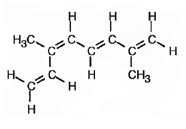
Explanation of Solution
The name shows that the longest carbon chain should contain eight carbons with two double bonds between C2 & C3 and C6 & C7. There should be two methyl substituents one on C2 and other on C6. Further higher ranked groups on C2 & C3 must be placed on the opposite sides of the double bond. The higher ranked groups on C6 & C7 must be placed on the same side of the double bond.
The structure corresponding to the systematic name (3E, 5Z)-2, 6-dimethyl-1, 3, 5, 7-octatetraene is

e) 3-Butyl-2-heptene.
Interpretation:
The structure corresponding to the systematic name3-butyl-2-heptene is to be drawn.
Concept introduction:
The longest carbon chain containing the double bond to be chosen. Based on the name of the parent compound–the alkene name ends with the suffix–ene. The chain is to be numbered from the end that gives the lowest number to the carbon in double bond. Substituents are to be numbered according to their positions in the chain and listed alphabetically. The position of the double bond is indicated by giving the number of the first alkene carbon before the name of the parent name. If more than one double bond is present, their positions are indicated with the suffixes -diene, -triene and so on.
To draw:
The structure corresponding to the systematic name 3-butyl-2-heptene.
Answer to Problem 38AP
The structure corresponding to the systematic name 3-butyl-2-heptene is
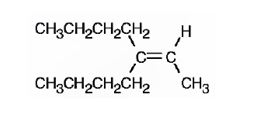
Explanation of Solution
The name shows that the longest carbon chain should contain seven carbons with a double bond between C2 & C3. There should be a butyl substituent on C3.
The structure corresponding to the systematic name 3-butyl-2-heptene is

f) trans-2, 2, 5, 5-Tetramethyl-3-hexene.
Interpretation:
The structure corresponding to the systematic name trans-2, 2, 5, 5-tetramethyl-3-hexene is to be drawn.
Concept introduction:
The longest carbon chain containing the double bond to be chosen. Based on the name of the parent compound–the alkene name ends with the suffix–ene. The chain is to be numbered from the end that gives the lowest number to the carbon in double bond. Substituents are to be numbered according to their positions in the chain and listed alphabetically. The position of the double bond is indicated by giving the number of the first alkene carbon before the name of the parent name. If more than one double bond is present, their positions are indicated with the suffixes -diene, -triene and so on. The isomer that has similar groups on each carbon on the same side of the double bond is called as the cis isomer. The isomer that has similar groups on each carbon on the opposite side of the double bond is called as the trans isomer.
To draw:
The structure corresponding to the systematic name trans-2, 2, 5, 5-tetramethyl-3-hexene.
Answer to Problem 38AP
The structure corresponding to the systematic name trans-2, 2, 5, 5-tetramethyl-3-hexene is
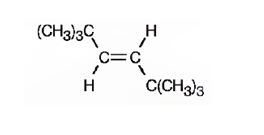
Explanation of Solution
The name shows that the longest carbon chain should contain six carbons with a double bond between C3 & C4. There should be four methyl substituents two on C3 and two on C5. Further similar groups in each carbon should be on the opposite sides of the double bonds.
The structure corresponding to the systematic name trans-2,2,5,5-tetramethyl-3-hexene is

Want to see more full solutions like this?
Chapter 7 Solutions
Student Value Bundle: Organic Chemistry, + OWLv2 with Student Solutions Manual eBook, 4 terms (24 months) Printed Access Card (NEW!!)
- Why do we analyse salt?arrow_forwardCurved arrows are used to illustrate the flow of electrons. Using the provided starting and product structures, draw the curved electron-pushing arrows for the following reaction or mechanistic step(s). Be sure to account for all bond-breaking and bond-making steps. H H CH3OH, H+ H Select to Add Arrows H° 0:0 'H + Q HH ■ Select to Add Arrows CH3OH, H* H. H CH3OH, H+ HH ■ Select to Add Arrows i Please select a drawing or reagent from the question areaarrow_forwardWhat are examples of analytical methods that can be used to analyse salt in tomato sauce?arrow_forward
- A common alkene starting material is shown below. Predict the major product for each reaction. Use a dash or wedge bond to indicate the relative stereochemistry of substituents on asymmetric centers, where applicable. Ignore any inorganic byproducts H Šali OH H OH Select to Edit Select to Draw 1. BH3-THF 1. Hg(OAc)2, H2O =U= 2. H2O2, NaOH 2. NaBH4, NaOH + Please select a drawing or reagent from the question areaarrow_forwardWhat is the MOHR titration & AOAC method? What is it and how does it work? How can it be used to quantify salt in a sample?arrow_forwardPredict the major products of this reaction. Cl₂ hv ? Draw only the major product or products in the drawing area below. If there's more than one major product, you can draw them in any arrangement you like. Be sure you use wedge and dash bonds if necessary, for example to distinguish between major products with different stereochemistry. If there will be no products because there will be no significant reaction, just check the box under the drawing area and leave it blank. Note for advanced students: you can ignore any products of repeated addition. Explanation Check Click and drag to start drawing a structure. 80 10 m 2025 McGraw Hill LLC. All Rights Reserved. Terms of Use | Privacy Center | Accessibility DII A F1 F2 F3 F4 F5 F6 F7 F8 EO F11arrow_forward
- Given a system with an anodic overpotential, the variation of η as a function of current density- at low fields is linear.- at higher fields, it follows Tafel's law.Calculate the range of current densities for which the overpotential has the same value when calculated for both cases (the maximum relative difference will be 5%, compared to the behavior for higher fields).arrow_forwardUsing reaction free energy to predict equilibrium composition Consider the following equilibrium: N2 (g) + 3H2 (g) = 2NH3 (g) AGº = -34. KJ Now suppose a reaction vessel is filled with 8.06 atm of nitrogen (N2) and 2.58 atm of ammonia (NH3) at 106. °C. Answer the following questions about this system: rise Under these conditions, will the pressure of N2 tend to rise or fall? ☐ x10 fall Is it possible to reverse this tendency by adding H₂? In other words, if you said the pressure of N2 will tend to rise, can that be changed to a tendency to fall by adding H2? Similarly, if you said the pressure of N will tend to fall, can that be changed to a tendency to rise by adding H₂? If you said the tendency can be reversed in the second question, calculate the minimum pressure of H₂ needed to reverse it. Round your answer to 2 significant digits. yes no ☐ atm Х ด ? olo 18 Ararrow_forwardFour liters of an aqueous solution containing 6.98 mg of acetic acid were prepared. At 25°C, the measured conductivity was 5.89x10-3 mS cm-1. Calculate the degree of dissociation of the acid and its ionization constant.Molecular weights: O (15.999), C (12.011), H (1.008).Limiting molar ionic conductivities (λ+0 and λ-0) of Ac-(aq) and H+(aq): 40.9 and 349.8 S cm-2 mol-1.arrow_forward
- Determine the change in Gibbs energy, entropy, and enthalpy at 25°C for the battery from which the data in the table were obtained.T (°C) 15 20 25 30 35Eo (mV) 227.13 224.38 221.87 219.37 216.59Data: n = 1, F = 96485 C mol–1arrow_forwardIndicate the correct options.1. The units of the transport number are Siemens per mole.2. The Siemens and the ohm are not equivalent.3. The Van't Hoff factor is dimensionless.4. Molar conductivity does not depend on the electrolyte concentration.arrow_forwardIdeally nonpolarizable electrodes can1. participate as reducers in reactions.2. be formed only with hydrogen.3. participate as oxidizers in reactions.4. form open and closed electrochemical systems.arrow_forward
 ChemistryChemistryISBN:9781305957404Author:Steven S. Zumdahl, Susan A. Zumdahl, Donald J. DeCostePublisher:Cengage Learning
ChemistryChemistryISBN:9781305957404Author:Steven S. Zumdahl, Susan A. Zumdahl, Donald J. DeCostePublisher:Cengage Learning ChemistryChemistryISBN:9781259911156Author:Raymond Chang Dr., Jason Overby ProfessorPublisher:McGraw-Hill Education
ChemistryChemistryISBN:9781259911156Author:Raymond Chang Dr., Jason Overby ProfessorPublisher:McGraw-Hill Education Principles of Instrumental AnalysisChemistryISBN:9781305577213Author:Douglas A. Skoog, F. James Holler, Stanley R. CrouchPublisher:Cengage Learning
Principles of Instrumental AnalysisChemistryISBN:9781305577213Author:Douglas A. Skoog, F. James Holler, Stanley R. CrouchPublisher:Cengage Learning Organic ChemistryChemistryISBN:9780078021558Author:Janice Gorzynski Smith Dr.Publisher:McGraw-Hill Education
Organic ChemistryChemistryISBN:9780078021558Author:Janice Gorzynski Smith Dr.Publisher:McGraw-Hill Education Chemistry: Principles and ReactionsChemistryISBN:9781305079373Author:William L. Masterton, Cecile N. HurleyPublisher:Cengage Learning
Chemistry: Principles and ReactionsChemistryISBN:9781305079373Author:William L. Masterton, Cecile N. HurleyPublisher:Cengage Learning Elementary Principles of Chemical Processes, Bind...ChemistryISBN:9781118431221Author:Richard M. Felder, Ronald W. Rousseau, Lisa G. BullardPublisher:WILEY
Elementary Principles of Chemical Processes, Bind...ChemistryISBN:9781118431221Author:Richard M. Felder, Ronald W. Rousseau, Lisa G. BullardPublisher:WILEY





